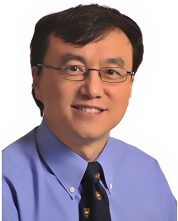Wireless Energy Harvesting and Power Transfer
Wireless energy harvesting (WEH) and wireless power transfer (WPT) are two closely related topics: they both employ a critical device – a rectenna, which is defined as the combination of an antenna and a rectifier. It receives RF/microwave waves and converts them into DC energy/power which can then be stored or used by application devices. It is expected this technology would produce higher energy conversion efficiency than photovoltaic technology for electromagnetic waves in the future.
Energy conversion efficiency is the critical and most important element for wireless energy harvesting (WEH) and wireless power transfer (WPT). How to design an efficient rectenna is a key challenge since this is a non-linear device whose performance is heavily affected by the input power and the load impedance.
WEH is motivated by the demand for a low-cost and low-power supplier for many Internet-of-Things (IoT) devices. The conventional battery is good for many applications, but it has to be changed now and then which means a waste of human resources and materials. Due to the widespread use of wireless systems, a lot of electromagnetic energies are around us and available in the ambiance environment at different frequencies (such as FM, TV, mobile, and Wi-Fi signals). Rectennas, especially broadband rectennas, are the ideal device to harvest these energies.
WPT is another major breakthrough that has made wireless charging possible and will enable many more anticipated ubiquitous IoT, EV, and medical applications. Unlike WEH, WPT is normally narrow-band and could be near-field or far-field. Thus the design requirements are different from WEH although they both use rectennas.
In this Lecture, we are going to
1) introduce the rectenna and review major historical events and developments;
2) provide a comprehensive review of rectenna designs (including different topologies and their comparison);
3) discuss the state-of-the-art designs (including such as the application of metamaterials and surfaces) and challenges (e.g. how to make it compact and efficient);
4) explain its applications in a range of WEH and WPT, including some very ambitious projects in the world.
Furthermore, it will include some life and video demonstrations produced by our research group.
Date and Time
Location
Hosts
Registration
-
 Add Event to Calendar
Add Event to Calendar
Loading virtual attendance info...
- Contact Event Hosts
- Co-sponsored by Sataracom Montreal
Speakers
 Prof. Yi Huang of University of Liverpool
Prof. Yi Huang of University of Liverpool
Wireless Energy Harvesting and Power Transfer
Biography:
Prof Yi Huang has been conducting research in the areas of antennas, wireless communications, applied electromagnetics, radar, measurements, and EMC since 1987. More recently, he is working on antenna developments using liquid and new materials, wireless energy harvesting and power transfer. His experience includes 3 years spent with NRIET (China) as a Radar Engineer and various periods with the Universities of Birmingham, Oxford, and Essex in the UK as a member of research staff. He worked as a Research Fellow at British Telecom Labs in 1994 and then joined the Department of Electrical Engineering & Electronics, the University of Liverpool, UK as a Faculty in 1995, where he is now a full Professor in Wireless Engineering and the Head of High-Frequency Engineering Group.
Prof Huang has published over 500 refereed papers in leading international journals and conference proceedings and authored four books, including Antennas: from Theory to Practice (John Wiley, 2008, and 2021). He has received many patents, and research grants from research councils, government agencies, charities, EU, and industry, and is a recipient of over 10 awards (e.g. BAE Systems Chairman’s Award 2017, and IET Premium Award for Best Paper 2022). He has served on a number of national and international technical committees and has been an Editor, Associate Editor, or Guest Editor of five international journals (including IEEE AWPL 2016-2022). In addition, he has been a keynote/invited speaker and organiser of many conferences and workshops (e.g. IEEE iWAT2010, LAPC2012, and EuCAP2018). He is at present an Associate Editor of IEEE Trans on Antennas and Propagation, UK and Ireland Rep to the European Association of Antenna and Propagation (EurAAP), a member of the IEEE AP-S New Technology Directions Committee, and a Distinguished Lecturer of IEEE-APS (2023-2025), and a Fellow of IEEE.
Address:United Kingdom

